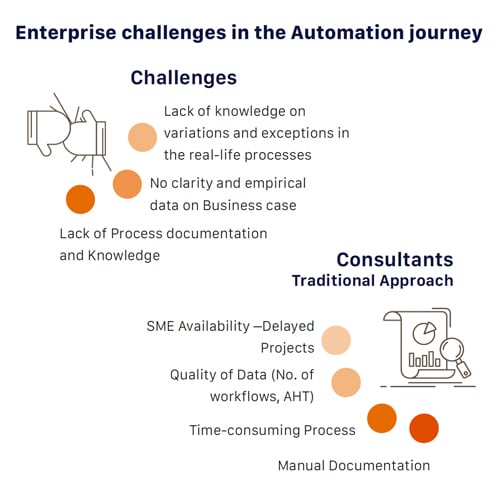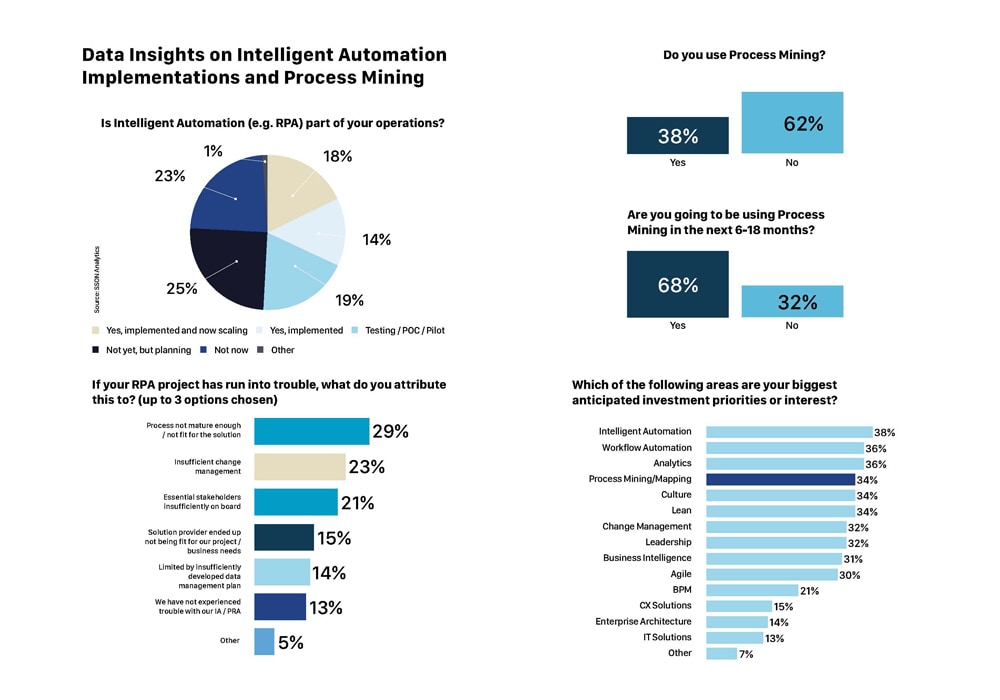
In the previous edition of The Edge Quarterly, we talked about the idea of Automation Singularity, a highly customer-centric and agility-oriented approach to Intelligent Automation. Driven by the human-digital twin, a seamless combination of digital and human workers, Automation Singularity serves as a beacon for enterprises to conceive, design, structure, and deliver products and services. In an environment driven by intense competition and increasingly demanding consumers, it will unlock unprecedented creativity and efficiency in the enterprise. However, with the desire for greater effectiveness comes the requirement for absolute clarity. Enter Process Discovery.
Although the benefits of RPA are beyond doubt, the implementation models across enterprises aren’t. All too often, initiatives fail not because enterprises lack intent, but because it’s misplaced. On the one hand, the identification of process candidates for Automation is rife with challenges and, on the other, enterprise-wide deployment and scale is often a stumbling block. Process Discovery provides a transformative solution by using empirical data to visualize manual effort and inefficiency in every process, offering a data-backed recommendation complete with opportunities for improvements.
Let there be light
The undeniable impact of RPA does not mean that advocacy is without its challenges. In an enterprise scenario, credible scenarios and use cases must drive any proposal for platform adoption. However, the old school of IT doesn’t quite rhyme with the bleeding edge. Managing processes, albeit complex and critical, remains a disproportionately manual role. Inevitably, process managers tend to have biases about the workflow and process construct that can contaminate the decision-making process. Add to that the lack of transparency in process evaluation, and it becomes easy to see why the approach needs an overhaul. Process Discovery identifies the processes best suited for Automation and, when used in conjunction with RPA, big data, and data analytics, can be a catalyst for agility.
Understanding Process Discovery
As an investigative tool, Process Discovery combinesthe best of business process management and data mining. It analyzes data from user key strokes in enterprise systems to identify, improve, and monitor actual processes. It employs empirical data for analysis to eliminate bias in enterprise Automation strategy and tactics, offering a better understanding of the right process candidates for digital transformation. More importantly, Process Discovery is a shot in the arm for teams looking to build a business case for Intelligent Automation. Enterprises can now review comprehensive Automation proposals empowered by process information across activities and users, gathered non-intrusively from actual execution data.
Calibrating for Impact
In the absence of up-to-date process documentation and knowledge which is a common occurrence across a majority of enterprises, it is practically impossible to have the required transparency around exceptions and variations.Working blind does not offer an environment conducive to the success of most initiatives; much less one focused on enterprise transformationat scale. The situation is exacerbated by the fact that consultants and process specialists traditionally rely on subject matter experts for recommendations, integrating bias into the Automation roadmap. Often, the resulting approach either fails to prevent, and often intensifies, the impact of process inefficiencies that cost businesses by way of increased expenses, delays, missed business opportunities, and a loss of revenue.

The Case for Process Mapping
The staggering opportunity cost of wrong process selection makes the most persuasive case for Process Discovery. The results of a 2019 industry survey conducted by the Shared Services and Outsourcing Network (SSON) drive this point home, that identifying the wrong process selection topped the list of causes for RPA performance failure. With experts stating that up to 50% of RPA projects either stagnate or fail, enterprises must find ways to address the hurdles in the implementation process. Enterprises face several challenges when choosing the right process candidates for Automation, from basing their decision on SME knowledge and manual documentation to low-quality data capture and delays in understanding process exceptions. It is here that Process Discovery comes into its own.
It gains credence by combining a holistic understanding of process nuances through workshops with process owners and subject matter experts before creating a high-level process flow of key activities. This approach also details whether a bot or a human executes the process. In addition to identifying automatable activities, delineating the various ways in which business and regions manage the same process, Process Discovery computes crucial business case metrics such as return on investment and payback period. This combination of clarity, coherence, and capability ensures that Process Discovery helps enterprises drive sustained results from Automation at scale as opposed to the unpredictable, and almost always unsatisfactory, outcomes of piecemeal interventions.

Why do we need to Automate Process Mapping?
Advantages
-
An alternative to the current manual, time consuming unrealizable approach
-
Process Discovery tool can be deployed across all user workstations at once
-
It can collate data irrespective of variations in SLAs or process steps
-
It captures process gaps and scope of optimization
-
Results are accurate as the input is taken from actual data across users

Catalyzing Growth at Scale
By drilling data down to an unprecedented level of granularity, breaking every process down to its bits and bytes, Process Discovery gives organizations powerful insights. In combination with machine learning and data mining, this information can be an incredible driver for digital transformation. A deeper understanding of processes sets the stage for cognitive capabilities, easily the most innovative tools for accelerated digital transformation through their ability to influence customer journeys and accelerate time to value. Once active, cognitive capacity can redesign operating models from the ground up, also rewiring processes, and injecting agility into the enterprise bid to meet the changing demands of the market and customers. It is evident that the most significant avenues for enterprise growth lie in acceleration and amplification, both of which require the elimination of inefficiencies, and process discovery is integral in this regard.
Enterprises looking to implement a process discovery solution must ensure certain key capabilities to drive sustained results.
Key capabilities to look out for in a Process Discovery product
-
Prioritize tasks with Automation Blueprint
-
Identify process nuances and variations
-
Automatic data capture
-
Highest level of granularity of data capture
-
Understand process nuances
-
Identify key process insights
-
Easy-to-use process maps
-
Data privacy compliance
Effectiveness Driven by Clarity and Focus
Process Discovery is at its most transformative when the insights it generates are followed by action. Once enterprises analyze the performance of a process against its original objective, specifically from a business standpoint, they can determine the key areas of focus. Armed with the clarity generated by Process Discovery, enterprises can start to generate sustained results from intelligent Automation at scale, furthering their progress towards harnessing the best of human and digital capabilities for growth, towards the holygrail of Automation Singularity.




